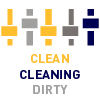Avoid Problems and Optimize your Baghouse Performance
Underperforming pulse jet baghouses are usually the result of high dust loading, inefficient cleaning systems - or a combination of both. Left unchecked, these problems can result in process bottlenecks and increased operating costs. Below are some steps you can take to avoid this from happening. If you need assistance, we have the unique expertise to identify and solve baghouse problems.
Recommended General Operation parameters:
Pressure: 90-100 PSI (May vary depending on material type)
Pay special attention to:
Reservoir
|
Poor filter cleaning can be the result of undersized or restricted cleaning system components. It is important to make sure that there are not any restrictions starting from the compressor all the way to the reservoir. Also, ensure that your header tank size matches your cleaning requirements.
|
|
|
|
Cleaning Air
|
Ensure better cleaning with tanks that are kept free of moisture and debris as they can substantially impact the ability to clean the filters.
|
|
|
|
Pulse Frequency |
The pulsing frequency can never be any faster than the reservoir can recover to full pulsing pressure. |
|
|
|
Pulse Sequence |
The pulse sequence should be adjusted to ensure that newly cleaned filters do not take in dust from the neighboring filter being pulsed. Staggering the firing order helps reduce cross-contamination. |
|
|
|
Hopper |
Should not be used for storage. Evacuation equipment (rotary valves, screw conveyors, etc.) should be sized to unload hopper before accumulation occurs. Units with slide gates should be left open and equipped with sealed drum adapters.
|
|
|
|
Emission/bleed through |
Due to emission regulations sometimes enforcing a change of filter media, still more dust collector owners seize this opportunity to upgrade to a more efficient filter media, which helps filter even the smallest particles thereby providing users the potential to recycle more of their valuable product and/or meet the required reduced emissions requirements. To reduce emission/bleed through, advantages can be achieved by upgrading from conventional filter bags to pleated bags with spunbond media or media with an ePTFE membrane. |
|
|
|
Choice of media |
All dust types have specific characteristics and require different handling. Therefore, it is often not enough to use a plain polyester media. Purchasing an enhanced treated/coated media (for example ePTFE membrane, HO treatment or antistatic surface) often turns out to be profitable as a result of better pulse cleaning. Some of the factors that influence the right choice of media are humidity, temperature, conductivity and acid. Read more about the most suitable solution for your industry |
|
|
|
Air flow |
Several issues can cause reduced air flow in the dust collector. The most common problem is the balance between the cleaning of filters and dust loading into the collector. These factors strongly influence the amount of airflow the system can handle. If you need to handle more ACFM, more filter area is usually required. Some customers choose to purchase longer bags or a new collector with more bags. Others choose a pleated bag solution which increases the filter area. |
|
|
|
Drop out box
|
The drop out box is the distance between the bottom of the filters and the hopper. The greater the distance, the better the conditions are for the heavier dust particles to be dropped from the airflow before contacting the filter surface area. To optimize the drop out box, install pleated bags which are shorter, as well as having more surface area. The increased drop out box removes the filter from the abrasion zone. |
|
|
|
|
Please notice: Some collectors may operate successfully under less stringent settings, while other collectors may fail under more conservative settings. |
|












